Diver's Paradise
Monday 1 May Ė Sunday 7 May 2000
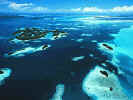 As
we stood waiting for our baggage to come through at Koror airport, we were in no
doubt that we had hit the diving Mecca of the world.
We were surrounded by hundreds of Japanese tourists who, having travelled
with nothing but dive equipment, were obviously here for one reason and one
reason only. Having said that, it
was primarily the opportunity to see some of the 1,500 species of reef fish and
700 different types of coral and anemones that had brought us here too Ö
although the guidebooks do try to stress that there is a lot more to Palau above
the waves.
As
we stood waiting for our baggage to come through at Koror airport, we were in no
doubt that we had hit the diving Mecca of the world.
We were surrounded by hundreds of Japanese tourists who, having travelled
with nothing but dive equipment, were obviously here for one reason and one
reason only. Having said that, it
was primarily the opportunity to see some of the 1,500 species of reef fish and
700 different types of coral and anemones that had brought us here too Ö
although the guidebooks do try to stress that there is a lot more to Palau above
the waves.
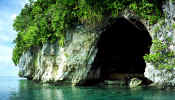 Although
Palauans were said to retain many of their traditional ways beneath a
veneer of Western consumerism, we obviously didn't look hard enough.
Certainly we saw nothing resembling traditional dress and as we drove
from the airport to the center of Koror, the main town, the western influences
were evident everywhere: modern office buildings, large tourist hotels, big
supermarkets and many, many restaurants, a large proportion of which seemed to
cater to Asian holiday-makers.
Although
Palauans were said to retain many of their traditional ways beneath a
veneer of Western consumerism, we obviously didn't look hard enough.
Certainly we saw nothing resembling traditional dress and as we drove
from the airport to the center of Koror, the main town, the western influences
were evident everywhere: modern office buildings, large tourist hotels, big
supermarkets and many, many restaurants, a large proportion of which seemed to
cater to Asian holiday-makers.
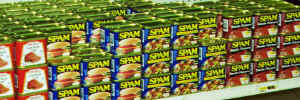
After a short walk around town
the next morning and a massive American breakfast at the Rock Island Cafť, we phoned around to arrange
some diving. Independent
travellers, we soon discovered, were somewhat of an anomaly in this part of the
world; most people arrived on pre-booked package tours with all diving included. In addition, this was a Japanese national holiday so any dive
shop specializing in Japanese dive guides was booked out.
But lady luck was on our side; not only did we find an excellent and well
run dive shop called Samís Dive Tours, but also started out with one of the
most knowledgeable and experienced dive guides either of us had ever had, Ethan.
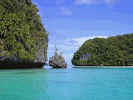 With
an ever-expanding waistline and continuous reminders that pregnant women really
couldnít dive, Pippa was once again relegated to circling the surface with a
snorkel while Eric descended into the depths and had the time of his scuba life
discovering species after species of new marine life.
Having
With
an ever-expanding waistline and continuous reminders that pregnant women really
couldnít dive, Pippa was once again relegated to circling the surface with a
snorkel while Eric descended into the depths and had the time of his scuba life
discovering species after species of new marine life.
Having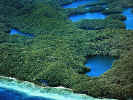 said that, some of the vertical drop offs were so spectacular that even the
snorkeling was superb in certain places and in addition, the boat ride out to
the dive sites gave us such an incredible view of the Rock Islands that it was
worth tagging along just for that.
said that, some of the vertical drop offs were so spectacular that even the
snorkeling was superb in certain places and in addition, the boat ride out to
the dive sites gave us such an incredible view of the Rock Islands that it was
worth tagging along just for that.
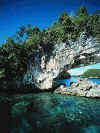 The
Rock Islands, 200 rounded knobs of limestone, are totally covered in green
jungle growth and are scattered across a 30 kilometre (20 mile) stretch of water south of
Koror. The bases of the islands are narrower than the tops having
been eroded by water, giving them a mushroom-like appearance.
Seeing how spectacular they were up
The
Rock Islands, 200 rounded knobs of limestone, are totally covered in green
jungle growth and are scattered across a 30 kilometre (20 mile) stretch of water south of
Koror. The bases of the islands are narrower than the tops having
been eroded by water, giving them a mushroom-like appearance.
Seeing how spectacular they were up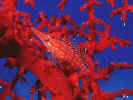 close, we decided to hire a kayak and take a couple of days to paddle around
them, stopping off to camp overnight somewhere we could find a beach.
Ethan had heartily recommended it but warned that if the water was rough,
it would make hard going; not something we were worried about on day one as we
sat under clear blue skies and scorching heat.
close, we decided to hire a kayak and take a couple of days to paddle around
them, stopping off to camp overnight somewhere we could find a beach.
Ethan had heartily recommended it but warned that if the water was rough,
it would make hard going; not something we were worried about on day one as we
sat under clear blue skies and scorching heat.
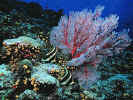 By
day two, the rain clouds had gathered and the wind had picked up speed.
Diving was still do-able but snorkeling became more difficult and
kayaking around the rock islands was definitely out. And so, Eric chalked up yet more dives and with them, more
tropical fish spotting. The
Ngemelis Wall (also known as the 'Big Drop Off') is widely considered the
worldís best wall dive. Starting
in water just knee deep, the wall drops vertically nearly 300 metres (1,000 feet) into the
deep blue ocean. There are some
spectacular corals
By
day two, the rain clouds had gathered and the wind had picked up speed.
Diving was still do-able but snorkeling became more difficult and
kayaking around the rock islands was definitely out. And so, Eric chalked up yet more dives and with them, more
tropical fish spotting. The
Ngemelis Wall (also known as the 'Big Drop Off') is widely considered the
worldís best wall dive. Starting
in water just knee deep, the wall drops vertically nearly 300 metres (1,000 feet) into the
deep blue ocean. There are some
spectacular corals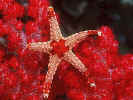 which are steadily growing back after suffering severely during El Nino a few
years back. But if corals and drop
offs were not your thing, there was always the Blue Corner, Palauís most storied
dive, known for its sheer abundance of underwater life.
Large numbers of sharks gather here in the strong tidal currents as well
as
which are steadily growing back after suffering severely during El Nino a few
years back. But if corals and drop
offs were not your thing, there was always the Blue Corner, Palauís most storied
dive, known for its sheer abundance of underwater life.
Large numbers of sharks gather here in the strong tidal currents as well
as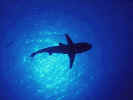 schools of barracuda and other fish. Despite
almost being swept away by the current, Pippa was determined to partake in the
shark experience so alone with her fins and snorkels, she circled about Eric and
the other divers praying that the alarming number of sharks patrolling the area
didnít fancy a bite of fat-tummied white woman.
schools of barracuda and other fish. Despite
almost being swept away by the current, Pippa was determined to partake in the
shark experience so alone with her fins and snorkels, she circled about Eric and
the other divers praying that the alarming number of sharks patrolling the area
didnít fancy a bite of fat-tummied white woman.
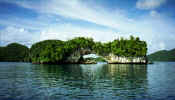 We
spent four days in total diving the key sites around Palau.
On the other two very rough and rainy days, we caught up with postcard
writing and ventured out to find somewhere else other than the Rock Island Cafť
to eat (once Eric finds a place serving good quality pizza, thereís no
stopping him). After just a week,
we were heading back to the airport to catch a flight to Guam where we would
connect on the Solomon Islands. We
were joined once again by hoards of Japanese tourists toting top-of-the-range dive
kit.
We
spent four days in total diving the key sites around Palau.
On the other two very rough and rainy days, we caught up with postcard
writing and ventured out to find somewhere else other than the Rock Island Cafť
to eat (once Eric finds a place serving good quality pizza, thereís no
stopping him). After just a week,
we were heading back to the airport to catch a flight to Guam where we would
connect on the Solomon Islands. We
were joined once again by hoards of Japanese tourists toting top-of-the-range dive
kit.
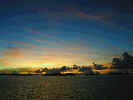 Somewhat
ashamed that we had not really delved at all into Palauan art or culture during
our stay, we perused the souvenir shop in the departure terminal and decided
that despite what the guidebooks said about Palau having one of the richest
artistic traditions in Micronesia, there was nothing we felt inclined to take
home with us. Even the traditional
Palauan storyboards, Palauís most unique art form and a smaller
version of the carved legends that were used to decorate the beams and gables of
menís meeting houses, looked tacky and uninspiring.
Somewhat
ashamed that we had not really delved at all into Palauan art or culture during
our stay, we perused the souvenir shop in the departure terminal and decided
that despite what the guidebooks said about Palau having one of the richest
artistic traditions in Micronesia, there was nothing we felt inclined to take
home with us. Even the traditional
Palauan storyboards, Palauís most unique art form and a smaller
version of the carved legends that were used to decorate the beams and gables of
menís meeting houses, looked tacky and uninspiring.
And so we prepared to leave
Micronesia and the North Pacific, heading onward to uncover some of the many
island groups around the South Pacific. But
first, we had an eight-hour stop-over in Guam and, keen to meet up again with
Judy (our traveling companion in Fais), we prepared ourselves for a whirlwind
sight-seeing tour of this tiny US territory.
Guam
Monday 8 May 2000
Without doubt, Guam is the
metropolis of Micronesia. Itís
the regionís largest island and
is not unlike a mini Hawaii with traffic jams, large shopping centres (complete
with a massive K-Marts), a university, huge resort hotels and potable tap
water. But as we were soon to
discover, it also has tropical forests, a mountainous interior, beautiful sandy
beaches and sleepy coastal villages.
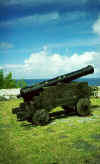 None
of this was apparent at the ridiculous hour of the
morning our plane landed; and in the pitch black of pre-dawn, we took a taxi to a nearby airport
hotel to get in a few hours sleep before meeting up with Judy. She was keen to make the most of the eight hours we had and so we set off on a tour
of the island, picking up some pastries and drinks en route to enjoy as we
circumnavigated the island.
None
of this was apparent at the ridiculous hour of the
morning our plane landed; and in the pitch black of pre-dawn, we took a taxi to a nearby airport
hotel to get in a few hours sleep before meeting up with Judy. She was keen to make the most of the eight hours we had and so we set off on a tour
of the island, picking up some pastries and drinks en route to enjoy as we
circumnavigated the island.
The capital city, Agana,
has been the centre of Guam since the Spanish period and there are certainly
several remnants of the Spanish colonial rule still remaining.
As we drove south, we began to enter the most scenic part of the island, full of
historic sites and beautiful vistas. We
stopped briefly in one of the tranquil villages to meet the chief, a friend of
Judyís, and learn more about the history of Guam and the traditions of its
native people. Sadly, we had too
little time to enjoy everything Guam has to offer but it was wonderful to see
Judy again and look through the photos she had taken in Fais and remind
ourselves what a great time we had had there.
After a brief check up at the
hospital, and a visit to K-Mart, as much for the novelty as to purchase some
much-needed insect repellent, we were heading once again for the airport and a
long flight to Fiji, bound for the Solomon Islands.
Sources: Many of the above photos are courtesy of
Sam's
Dive Tours.